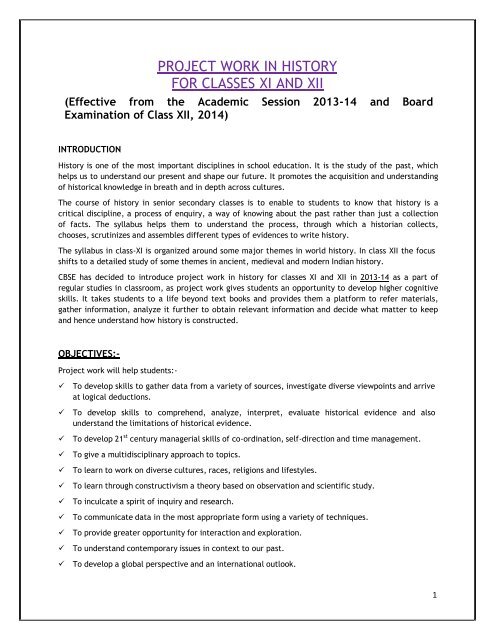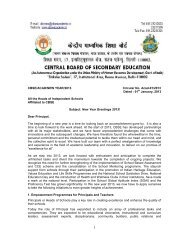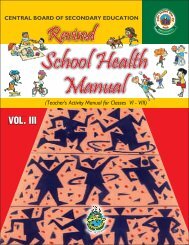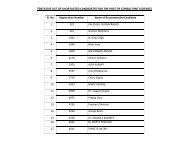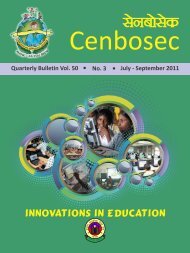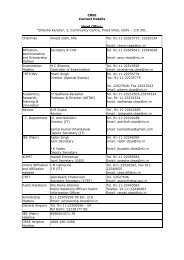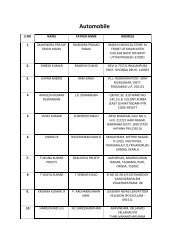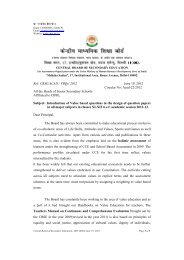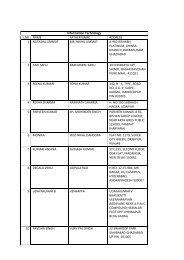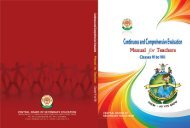PROJECT WORK IN HISTORY FOR CLASSES XI AND XII - CBSE
PROJECT WORK IN HISTORY FOR CLASSES XI AND XII - CBSE
PROJECT WORK IN HISTORY FOR CLASSES XI AND XII - CBSE
Create successful ePaper yourself
Turn your PDF publications into a flip-book with our unique Google optimized e-Paper software.
2. Data/Statistical analysis/Map work 3 Marks3. Visual/overall presentation 5 Marks4. Analysis/explanation and interpretation 5 Marks5. Bibliography 1 Marks6. Viva 4 MarksTotal20 MarksNote:-The project reports are to be preserved by the school till the final results are declared, forscrutiny by <strong>CBSE</strong> or by parents at anytime.3
CLASS <strong>XI</strong>I<strong>PROJECT</strong> <strong>WORK</strong>Book 1THEMES <strong>IN</strong> <strong>IN</strong>DIAN <strong>HISTORY</strong>-PART ITOPIC: Town planning and Artifacts of the Harappan civilization.Objectives: The purpose of this study is as follows:It will help students to understand the importance of artifacts as a source for studying ancientcivilizations.Students will appreciate the town planning of Harappan Civilization and can compare it withthe modern towns and cities.It will create awareness on the kind of life people led then.Methodology:(1) This project could be introduced to the students, by the teacher in the following ways-‣ Visiting the Harappan section of the National Museum in Delhi (If one lives in Delhi or close toit)‣ Reading a story called ‘Foot loose in the City’ from the collection of stories called ‘Th eForbidden Temple’ ( Refer to sources) and list out the features and characteristics of theprotagonist’s lifestyle and city‣ Having a general discussion about the Harappan civilization (This should be done only after thefirst chapter has already been taught in class).‣ They can surf the net and can get the details about the Harappan civilization.(2) After introducing the topic an activity to be organized, in order to help the students to know howartifacts are used to gauge information about a civilization. Each person should bring an object toclass. This could be an object of daily use or even something like a vase, sculpture, artificialjewelry, accessory etc. The objects should be put together and the class may be divided intogroups of four or five. Each group to discuss about at least five objects on the basis of questions-[sample questions given below. What is the material out of which the object is made? What are the different ways in which these objects could be used?4
How did one find out about the uses of the object? (Was it by comparing it with other objects,or by asking people etc?) What does the object tell about the lifestyle of the person who uses it?One member from each group may tell the class about the inferences drawn and a general classdiscussion could follow. This activity would help the students to realize how archeologists andhistorians look at objects in different ways to extract information from them.(3) After this, the study becomes more focused as information about different artifacts is collected.One way to do this would be to divide students into groups of four or five and asking each group tochoose one of the following artifacts given in the text book, Beads and jewelry Sculptures and figurines Tools and equipments Seals and weights Pottery and utensilsThe information could be collected from the section on ‘Sources’ of the text book, visit to amuseum or visit the site if living close by. It can be analyzed keeping the following points in mind- The description of the artifact Where the materials have come from? What might have they been used for ? How could experts have found out information about its utility? What specific details does it give about the Harappan culture?Presentation(1) In the form of an exhibition, the students could create ‘An ancient Harappan market’. Stalls couldbe set up in the site of the exhibition and the artifacts that the students have collected\studiedcould be displayed as things that are sold in the market. The market could include a workshop forthe production of seals too. The students could also dress up like the Harappans and pretend to beshopkeepers, merchants, traders, artisans, musicians, peasants (who have come to sell theirgrains) and town dwellers. A barter system could be shown. This exhibition could also be put uparound the model of the miniature city made by the students using cardboards, wooden planks,sand etc.(2) The students can make presentation in the form of a report, based on the research work done.5
AssessmentThe total marks allotted for the project will be 20 marks. The following are the methods and criteriafor evaluation: Research contribution:These marks are to be entered by the teacher when the activities and the research are beingconducted. Each student will get marks individually according to his/her involvement.Involvement in activity2 marksUnderstanding of concepts discussedResearch contribution (Total)3 marks5 marksReport Writing:Content and Presentation2 marksAnalysis, interpretation and inferences drawn4 marksWritten Report Assessment (total))6 marks Thus evaluation would include :Research contribution (Total)5 marksWritten Report Assessment (Total)6 marksIndividual presentation /explanation (Total)5 marksViva4 marksTotal20 marksSources:Books:1. Raymond and Bridget Allchin.1997. Origins of Civilization. Viking, New Delhi2. G.LPossehl. 2003. The Indus Civilization.Vistaar, New Delhi.3. ShereenRatnagar. 2001. Understanding Harappa.Tulika, New Delhi.4. T.V Padma. 2004. The Forbidden Temple.Tulika, New Delhi.5. A.L Basham. 2004. The Wonder that was India, Third Revised Edition.Picador India, London.6. Upinder Singh. 2002. Mysteries of the Past-Archaeological Sites in India. National Book Trust,India,New DelhiInternet:1. www.harappa.com/har/harreso.html2. www.ancientcivilizations.co.uk/home_set.html3. http://en.wikipedia.org/wiki/Indus_Valley_Civilization4. www.thenagain.info/webchron/india/harappa.html6
II. Mahabharata through a Readers eyeHow have local beliefs interacted, shaped and been influenced by other ‘greater traditions’ to formdifferent versions and stories of the Mahabharata and how this epic has been projected through variousforms.Objectives:‣ It will help the students to understand how the great epic Mahabharata, as an oral tradition,was transmitted from generation to generation.‣ It will help them to become aware of the fact that when societies meet with each other, theycombine and interact in order to form new traditions in societies.‣ It will help them to explore how this epic has been portrayed in different ways across thecountry in different forms.‣ It will help them appreciate the fact that the Mahabharata was not written by one person, butwas an oral tradition, reflected in cultures across the subcontinent in various forms like dance,music, stories, paintings etc.‣ Students will learn to critically analyze the position, and status of women during that period.‣ Students will also be able to understand and evaluate the growth and development of the varnasystem prevalent at that time.Methodology:1) This project should be taken up after the second and third theme from the first book is completed,so as to ensure that the students have a basic understanding of the economy, society and politicsduring the period 600 BCE-600CE. The opening discussion should be a general class discussion onsimilar lines.2) Students can interview their parents, grandparents, relatives and other people in their locality toknow about their stories/sources/perceptions of Mahabharat & social and political life of thepeople Mahabharat.3) Next, in groups of four or five, the students should share and discuss their ideas & findings. If theclass consists of children from different regions, then those with similar findings and region can begrouped together. The teacher should spend some time with each group to guide the discussion.During the discussion, the students could focus on questions like:Which story did the respondent choose to narrate and why?Had you heard this story before?Was this a common story that is prevalent all over India? Or was it different?Did the story include things/places/temples/structures/people/ practices that are closelyrelated to your locality or situated very close to it?How did the respondent feel about the characters of the Mahabharat? Do they feel theiractions were justified?7
Internet:1) http://bombay.indology.info/mahabharata/statement.html2) http://www.indiaheritage.org/index.htmMovies: The Mahabharata.1989. Directed by Peter Brook. TV Serial of Ramanand Sagar.10
THEMES <strong>IN</strong> <strong>IN</strong>DIAN <strong>HISTORY</strong>PART IITopic: Through the Travelers Eyes;The experiences of Travelers who visited the subcontinent and how their accounts help us tounderstand the history of that region in the medieval period.Objectives:‣ This project will familiarize the students with the various travelers who travelled to this part of theworld.‣ It will help the students to understand the trials and travails of the travelers during the medievalperiod It will give them a holistic picture of the medieval era (the lifestyle of the people, thetowns, the terrain, the climate, languages spoken etc.) as they comprehend the impressions leftby travelers.‣ It will lead to the development of the following skills in the students: Ability to gather information from various sources Ability to understand and critically analyze a source by taking into account, its context,purpose and other factors Ability to synthesize all the information and present it in an ‘easy-to-understand’ manner Cooperation, teamwork and leadership qualities.Methodology:1) The class may be divided into groups of three to four. Each group can choose any one of thefollowing travelers:Ibn BatutaAl BiruniMarco PoloNicolo ContiAbdur RazaqFrancois BernierAthanasius NikitinDuarte BarbosaJean-Baptiste TavernierJesuit Roberto Nobili11
ManucciThomas RoeRalph Fitch2) The students may be asked to research on their chosen traveler. They should list down thedifferent sources they need to look for information, the sub-topics that need to be researched andpreparation of presentation. Information can be collected in the form of pictures, notes,recordings, sketches etc.3) After all the information has been collected the group members could sit together and discuss thefindings.4) After the discussion, the conclusion and inferences should be systematically written down and atravelogue can be prepared.Presentation:Since each student would not be studying about all the travelers, They can form groups and make apresentation as project file or Role play or PPP.I. Project file: This should consist of an introduction, and all the information under various subheadings.The inferences drawn in the discussion should be included in the conclusion.Questions such as :1) Why people traveled at that time?2) How feasible was it to travel ?3) How is traveling today different? should be addressed.4) What were the findings of their travels?It would be advisable that the students incorporate pictures, anecdotes, stories, maps, etc. in thefile. However all these components should have some significance. The project report should alsoinclude acknowledgements and a bibliography.II. Role play: The presentation for the class can be in the form of a 10 minute skit. It could consist ofthe following characters:The traveler: This student would talk about herself/himself as the traveler and mentioninformation about the traveler’s birth, education etc. She/he should also use a map to show theregions that the traveler visited. Lastly the student should speak about the traveler’s experience infirst person.The ruler: This student could represent the ruler/king of the region that the traveler visited. Thisstudent could give a brief introduction about the kingdom and then talk about the travelers visit tothe court.12
The archaeologist: This student would talk about the accounts of the traveler, how it was writtenand how it was found and understood.The historian: This student will give the conclusion and talk about how the imperious left by thistraveler have helped in the study of history.III. Power point Presentation: on the above contentAssessmentThe total marks allotted for the project will be 20 marks. The following are the criteria for evaluation:Project file/Power point Presentation:20 marksOriginality and maturity of inferences drawn and conclusionDiversity of sources used, taking into consideration the sources that were accessible4 marks4 marksContent(other than conclusion)Organization and creativity reflected in the final fileProject file/PPT (total)Total4 marks2 marks6 marks20 marksAssessment for Role play:-Content and its oral presentationOrganization and overall presentationCreativity, props usedRole play (total)WorksheetTotal2 marks2 marks2 marks6 marks8 marks20 marks(Worksheet to supplement the assessment of role-play, The teacher should prepare aworksheet based on the topic and administer it in the classrooms)If all 3 activities are conducted then evaluation would be based on:Project file/Power point PresentationRole playWorksheetTotal9 marks6 marks5 marks20 marks13
Sources:Books:1) Muzaffar Alam and Sanjay Subrahmanyam. 2006. Indo-Persian Travels in the Age ofDiscoveries, 1400-1800. Cambridge University Press, Cambridge.2) Catherine Asher and Cynthia Talbot. 2006. India Before Europe. Cambridge University Press,Cambridge.3) Francois Bernier.nd. Travels in the Mogul Empire A.D 1656-1668.Low Price Publications. NewDelhi.4) H.A.R Gibb(ed.). 1993. The Travels of Ibn Batuta .Munshiram Manoharlal, Delhi.5) MushirulHasan (ed.). 2005. Westward Bound: Travels of Mirza Abu Talib.Oxford UniversityPress, New Delhi.6) H.K Ka ul (e d .) . 1 9 9 7 . Tra v e l l e rs ’ Ind ia -an Anthology.Oxford University Press, NewDelhi.7) Jean- BaptisteTavernier.1993. Travels in India.Munshi Manoharlal, Delhi.Internet:1) www.edumaritime.org2) www.kamat.com/kalranga/itihas/foreign-accounts.htm Also, gather information from libraries ,archival records in museums (National Museum andNational Archives in Delhi),paintings( museums, books, textbooks), by talking to professors ofuniversities, historians and archeologists) and maps.14
Topic: Understanding the Bhakti-Sufi Movement in India.Objectives:(a) This project will help the students to comprehend, analyze and be aware of the ways and meansby which the poets and saints of the Bhakti and Sufi movement tried to disseminate their ideasand how these ideas changed the society.(b) Students can appreciate how art, literature and stories played an important role in communicationand shaped their ideas.(c) It will help them to critically study the sources in detail and draw inferences from it.Methodology:Students can pick up stories, poems, bhajans or any composition that they have heard in school,temple, dargah or media.Visit to a Dargah in your local area (for information on Sufi music)The students can write a short description of the chosen/visited dargah and then reflect on theactivities observed there and relate it with information in textbooks.1) After familiarizing oneself with the area of the study, the student could draw the inferences withthe help of an expert in the field of historical studies.2) After the discussion the student should brainstorm to prepare as many questions as possible.She/he should then incorporate these into a proper sequence of events.3) As per guidance from the class <strong>XI</strong>I history textbook and other sources the student could find outmore information and research about the composition and discourses that is the focus of his/herstudy and other similar compositions from the same tradition.1) A report must be prepared by each student individually. It must include the following components:The introduction about the bhakti and sufi traditionA description about the composition and where it was procured from and its meaning should bewritten.A detailed section describing the discussion with the expert. The opinions and reflections made by different people in the locality of the dargah, localstories related to the dargah could also be included.Lastly, a section about how such compositions helped in propagating ideas related to a tradition.15
Presentation:The presentation could be divided into three parts:Project report: This should consist of a formal report with all the information under various subheadingsas per project guidelines. The inferences drawn should be included in the conclusion. Itwould be advisable that the students incorporate sketches, photographs maps, etc. in the report. Itcould be typed out or hand written.Group Discussion: Five to six students could be put together in a group and asked to discuss theirfindings. Each student would be given 2 to 3 minutes. A general discussion would follow, afterwhich each student has to give a conclusion.Viva-voce: A short viva could be conducted by the teacher in order to understand the studentspecific questions related to his/her report.AssessmentThe total marks allotted for the project will be 20 marks. The following are the methods and criteriafor evaluation:Project report:Report on the discussion and the surveySources usedContent and organizationOriginality and maturity of inferences drawn and the conclusionProject Report (total)Group discussionUnderstanding of subject and relevance of the points madeParticipation and cooperationConclusionGroup discussion (total)3 marks2 marks2 marks3 marks10 marks3 marks1 mark1 mark5 marksViva-voceUnderstanding of the projectEfficiency in answering questions with examplesViva Voce (total)3 marks2 marks5 marks16
Thus, the evaluation would be based on:Project reportGroup discussionViva-voceTotal10 marks5 marks5 marks20 marksSources:Books:1) R ichard m. Eat on (ed.) . 2003. I ndia’s I slamic Tradit ions.Oxford U nive rsit yPress, N ewDelhi.2) John Stratton Hawley. 2005. Three Bhakti Voices- Mirabai, Surdas and Kabir in their times andours.Oxford University Press, New Delhi.3) David N. Lorenzen (ed.). 2004. Religious Movements in South Asia 600-1800.Oxford UniversityPress, New Delhi.4) A.K Ramanujam. 1981. Hymns for the Drowning. Penguin, New Delhi5) Annemarie Schimmel. 1975. Mystical Dimensions of Islam. University of North Carolina Press,Chapel Hill.6) David Smith. 1998. The Dance of Siva: Religion, Art and Poetry in South India. CambridgeUniversity Press, New Delhi.7) Charlotte Vaudeville. 1997. A Weaver Named Kabir. Oxford University Press, New Delhi.Web resources:1) www.alif-india.com17
Topic: Depiction of Life during Mughal period through Paintings.Objectives:This project will help to:1) familiarize the students with the various aspects of the Mughal Empire such as administration,court proceedings, domestic life, life of commoners, war and trade etc.2) understand the ways and means by which the emperors tried to shape and disseminate ideas thatthey wanted the people to believe in.3) comprehend the relations between various players in the empire- the state, the merchants, thepeasants, the Sufi saints, the neighboring empires, poets and artists etc.Methodology:1) This project could be done as a whole class project and presented in the form of an exhibition atthe end. Each student or a group of students could be assigned a particular sub-topic eg.politicallife or social-norms, or cultural scene, through miniature paintings.2) Each group should first try and identify all the miniature paintings related to their sub-topic fromthe text book and then move on to scrutinizing them. Their descriptions should be written downwith emphasis on the colors, patterns and activity portrayed.3) These observations should be combined with information from other types of sources like theinternet etc and with inferences drawn from discussions with experts (if possible). At the end, thegroup could produce a concise write-up about their subtopic, constantly giving examples frompaintings. Emphasis should be given on how these paintings must have impacted people.4) After this, an exhibition could be put up. Groups could be assigned different duties like:Preparing the final write-upsSelect and preparing the paintings for displayPreparing the time line and the mapsMaking more paintings/drawings and decorationPhotographyFinal layout, organization and supervisionLogistical arrangements: Boards, art material, decorative materials, furniture etc.Presentation:Students would be evaluated based on three things:1) Group topic: The work of each group would be evaluated separately. The choice of paintings,inferences drawn and interpretation and presentation would be judged.18
2) Contribution to the exhibition: Each group would also be evaluated on the basis theircontribution and efficiency and involvement while putting up the final exhibition3) Individual presentation: Every student should present and explain a part of the section thathis/her group is in charge of.AssessmentThe total marks allotted for the project will be 20 marks. The following are the methods and criteriafor evaluation:Group workOriginality and maturity of inferences drawn and conclusionHow well have the paintings been related to the information about thesubtopicContent(other than conclusionOrganization and creativity reflected in the presentationGroup work (total)2 marks2 marks2 marks2 marks8 marks Individual presentation/explanation- Marks to be given individuallyContent and its oral presentation2 marksUnderstanding of the topic2 marksIndividual presentation/explanation (total)4 marks Individual contribution 4 marksThese marks have to be entered by the teacher based on his/her observation of each student whilethe exhibition was being put up. Overall impact and presentationThese marks are to be given to the class as a whole i.e. each student will get the same marksbased on their coordinated effort.Overall impact, presentation and relevance2 marksCreativity, originality and visual appeal2 marksThus, the evaluation would be based on:Group workIndividual presentation/explanationIndividual contribution8 marks4 marks4 marks19
Overall impact and presentationTotal4 marks20 marksSources:Books:1) Bamber Gascoigne. 1971. The Great Moghuls. Jonathan Cape Ltd, London.2) Shireen Moosvi. 2006 (rpt). Episodes in the Life of Akbar National Book Trust, New Delhi.3) Harbans Mukhia. 2004. The Mughals of India. Blackwell, Oxford.4) John F. Richards. 1996. The Mughal Empire (The New Cambridge History of India,Vol.1).Cambridge University Press, Cambridge.5) Annemarrie Schimmel. 2005. The Empire of the Great Mughals: History, Art andCulture.Oxford University Press, New Delhi.Internetwww.mughalgardens.org20
THEMES <strong>IN</strong> <strong>IN</strong>DIAN <strong>HISTORY</strong>-PART IIITOPIC :How the Partition in 1947 was not just a division of territory but also a division of hearts and how itaffected the common people.Objectives: This project will make students of this generation aware of the reasons, processes,decisions involved in the partition of our country and the consequences of this tragic phenomenon. Thepurpose of this project would be to supplement and deepen this understanding of the partition.It will help the students empathize and look at this event from the eyes of those whoexperienced it and were affected by it.It will enable them to understand and comprehend the hardships borne by the people duringpartitionIt will help students critically analyze the importance of the experiences of people as a sourcefor rebuilding the pastIt will familiarize them with the perceptions to people about the partition todayMethodology:As a part of their holiday assignment, the students could be asked to read/watch one or more of thebooks mentioned in the Sources section of the textbook. They could also go through the anecdotes inthe textbook (even the Political Science textbook- Indian Politics since Independence has anecdotes inthe first chapter itself)1.Data CollectionEach student can ask their grandparents or other elders about their experiences of Partition. Questionssuch as the following could be asked: Where were you living and what were you doing (school/college student, employed, married etc.)when the Partition took place? Were you required to migrate? Or were you in a locality from where others migrated and thennew people came? Share some experiences related to Partition was it a period full of violence and riots? What were the different changes that partition brought about? What do you feel about it today?The students should note that these are just some examples of questions that could be asked. They arefree to innovate and come up with their own questions. Also, open ended questions should be asked so21
that the respondents can freely express themselves and emotionally connect to their narration ifpossible. The experiences should be meticulously recorded.2. After this each student could prepare a set of three to five questions about how individuals relateto the Partition and what they think of it today. This survey like study could be carried out in thelocality or it could also be done in schools The reasons behind a person’s opinion should also benoted. Again, people from different communities could be consulted so as to get a completepicture( talk to at least 10 people).3. After this primary researching, the students could be divided into groups of four to five to discussthe findings. A group leader would speak about the gist of a discussion and the inferences drawnfrom it.4. Based on these findings, the students could either write a report or a story individually.5. Simultaneously, the group could decide on one or two anecdotes and make a script for a play.Presentation:The report that the students submit should be concise & well organized. Interviews can be recordedand played by the students for a better impact in both types of presentations.As for the play/skit, students can experiment with props and costumes as well. The skit could includesongs and poems.Assessment: Participation in discussions 3 marks Originality and understanding reflected while researching- 3 marks SkitUnderstanding and scriptPresentation, individual part and actingOverall impactSkit (total)2 marks2 marks2 marks6 marksReport/ScriptContentInferences drawnOrganization and innovationReport/script (total)2 marks2 marks2 marks6 marks22
Thus, evaluation would be based on:Participation in discussions-Originality and understanding reflected while researchingSkitReport/ScriptViva-voceTotal3 marks3 marks6 marks6 marks2 marks20 marksSources:Books:1.Jasodhara Bagchi and Subhoranjan Dasgupta (eds.). 2003. The Trauma and the Triumph:Gender and Partition in Eastern India .Street, Kolkata.2.AlokBhalla (ed.). 1994. Stories About the Partition of India, Vols. I,II,III.Indus (HarperCollins), New Delhi.3.UrvashiButalia. 1998. The Other Side of Silence: Voices from Partition of India.Viking(Penguin Books), New Delhi.4.MushirulHasan, ed. 1996. India ’s Pa r tit io n. Oxford University Press, New Delhi.5.GyanendraPandey. 2001. Remembering Partition: Violence, Nationalism and History in India.Cambridge University Press, Cambridge.6.Anita Inder Singh. 2006. The Partition of India. National Book Trust, New Delhi.Novels for Reading:Internet:1.Khushwant Singh. 2009. Train to Pakistan. Penguin Books India, New Delhi.2.BhishamSahni. 2008. Tamas. Penguin Books India, New Delhi.1)http://asianhistory.about.com/od/india/f/partitionofindiafaq.htm2)http://www.bbc.co.uk/history/british/modern/partition1947_01.shtm3)http://www.indianetzone.com/42/impact_partition_india.htm23


